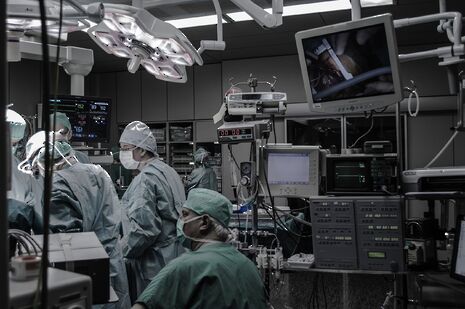Awake during brain surgery: how cutting-edge interdisciplinarity is helping tumor patients
In Addenbrooke’s operating theatres, medicine meets neuroscience

The patient, lying awake during brain surgery in an operating theatre, starts counting “one, two, three, four…”, then paused before carrying on “five, six…”. He didn’t mean to pause – he was forced to, because the neurosurgeon had sent an electrical pulse to a part of his brain responsible for speech, leaving him, if only for a moment, mute.
Zapping brains, and thereby temporarily switching off certain areas, is standard procedure during awake neurosurgeries. Doctors usually opt for this approach when trying to remove a tumor that has grown close to, or is merged with, healthy tissue. If patients stop being able to do basic things, such as counting or moving their fingers while a certain brain area is silenced, then the surgeon knows not to remove it in order to preserve the functions this brain area is responsible for.
But how can the neurosurgeon avoid cutting out brain tissue involved in less basic, subtler cognitive functions, such as the ability to concentrate, or to switch attention from one task to another? One problem is that sending electrical pulses to brain areas involved in such functions wouldn’t lead to an immediately observable impairment like losing the ability to speak. To solve this problem, we have developed a novel approach whereby we place electrodes on the surface of patient’s brains, which allows us to record neural activity in the operating theatre. We then force the brain to multi-task, for example, by asking the patient to alternately count numbers and letters: “1, a, 2, b, 3, c…” This task is already tricky enough when you are not undergoing a brain surgery – just see how far you can go yourself! A computer algorithm analyses the signals detected by the electrodes as the patient performs this and other kinds of cognitive tasks, giving real-time feedback to the surgeon. This allows the surgeon to better predict the likely impact that the removal of a particular piece of brain tissue would have on the patient’s cognitive functions.
"Our research could transform brain surgeries"
The recorded electrical brain activity will also help neuroscientists to construct a more detailed map of brain function, something that is hard to do with less invasive methods such like brain scans. In the long term, we are working on developing software which doctors can use during surgery. The idea is to integrate the data we are currently collecting with brain scans of patients obtained before surgery. This way, our research could transform brain surgeries by offering the patient a better understanding of the risks to take before the surgery and providing neurosurgeons a more accurate mapping of each patient’s brain.
 Comment / Plastic pubs: the problem with Cambridge alehouses 5 January 2026
Comment / Plastic pubs: the problem with Cambridge alehouses 5 January 2026 News / Uni-linked firms rank among Cambridgeshire’s largest7 January 2026
News / Uni-linked firms rank among Cambridgeshire’s largest7 January 2026 News / New movement ‘Cambridge is Chopped’ launched to fight against hate crime7 January 2026
News / New movement ‘Cambridge is Chopped’ launched to fight against hate crime7 January 2026 News / SU stops offering student discounts8 January 2026
News / SU stops offering student discounts8 January 2026 News / Cambridge businesses concerned infrastructure delays will hurt growth5 January 2026
News / Cambridge businesses concerned infrastructure delays will hurt growth5 January 2026








